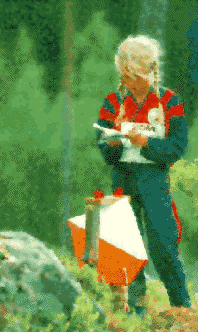

Orienteering is a sport in which orienteers use an accurate, detailed map and a compass to find points in the landscape. It can be enjoyed as a walk in the woods or as a competitive sport.
A standard orienteering course consists of a start, a series of control sites that are marked by circles, connected by lines and numbered in the order they are to be visited, and a finish. The control site circles are centered around the feature that is to be found; this feature is also defined by control descriptions (sometimes called clues). On the ground, a control flag marks the location that the orienteer must visit.
To verify a visit, the orienteer uses a punch hanging next to the flag to mark his or her control card. Different punches make different patterns of holes in the paper.
The route between "controls" (refers to the flag or the site) is not specified, and is entirely up to the orienteer; this element of route choice and the ability to navigate through the forest are the essence of orienteering.
Most orienteering events use staggered starts to ensure that each orienteer has a chance to do his or her own navigating, but there are several other popular formats, including relays and events in which the orienteer must find as many controls as possible within a specified time.